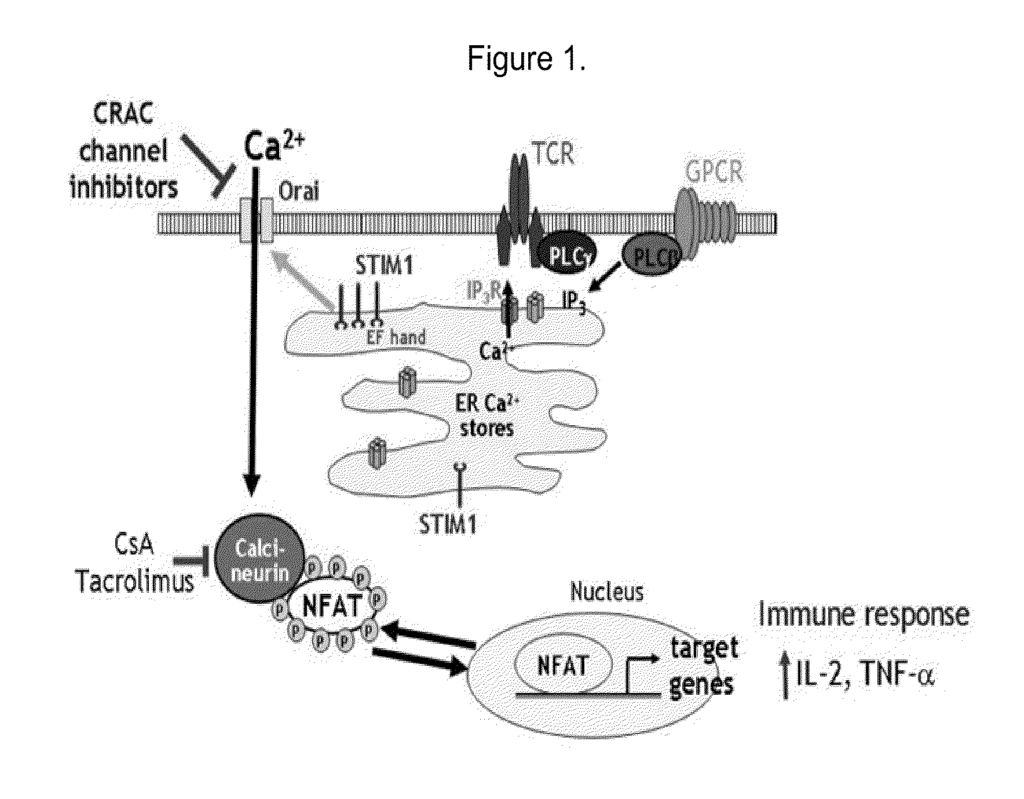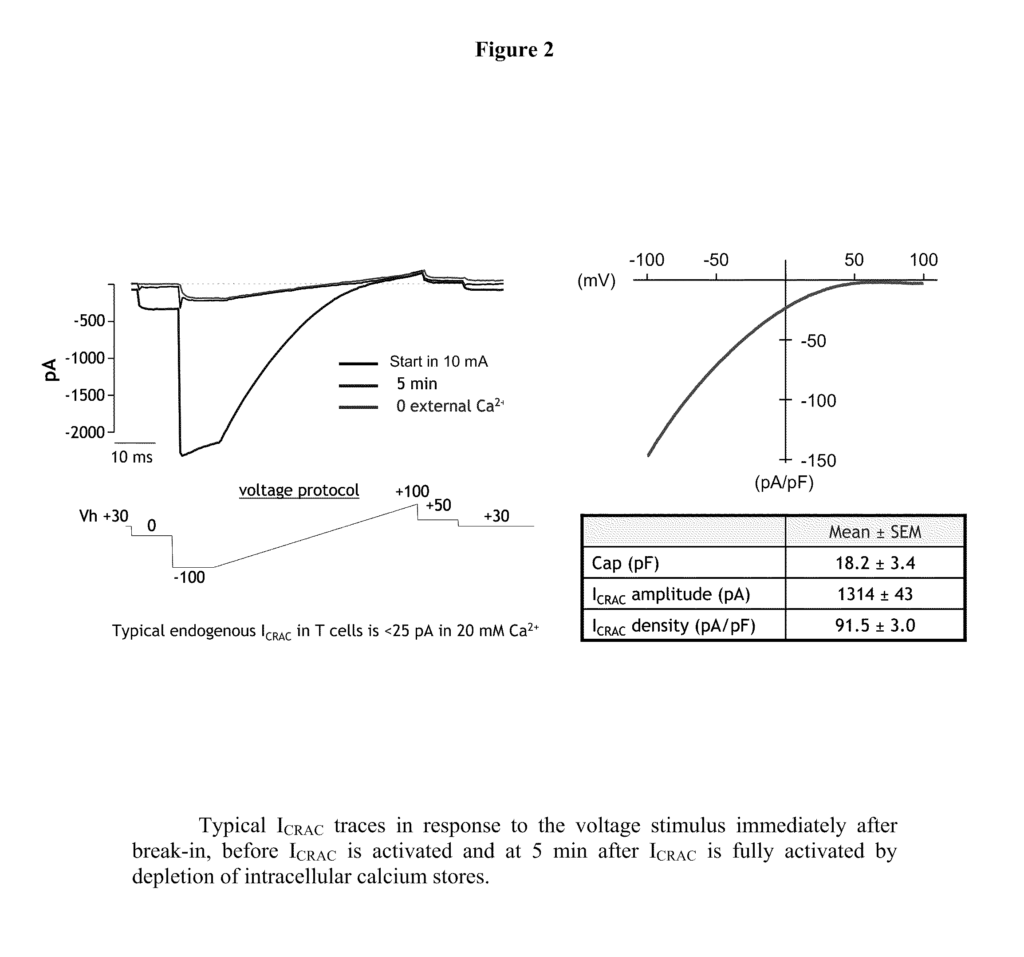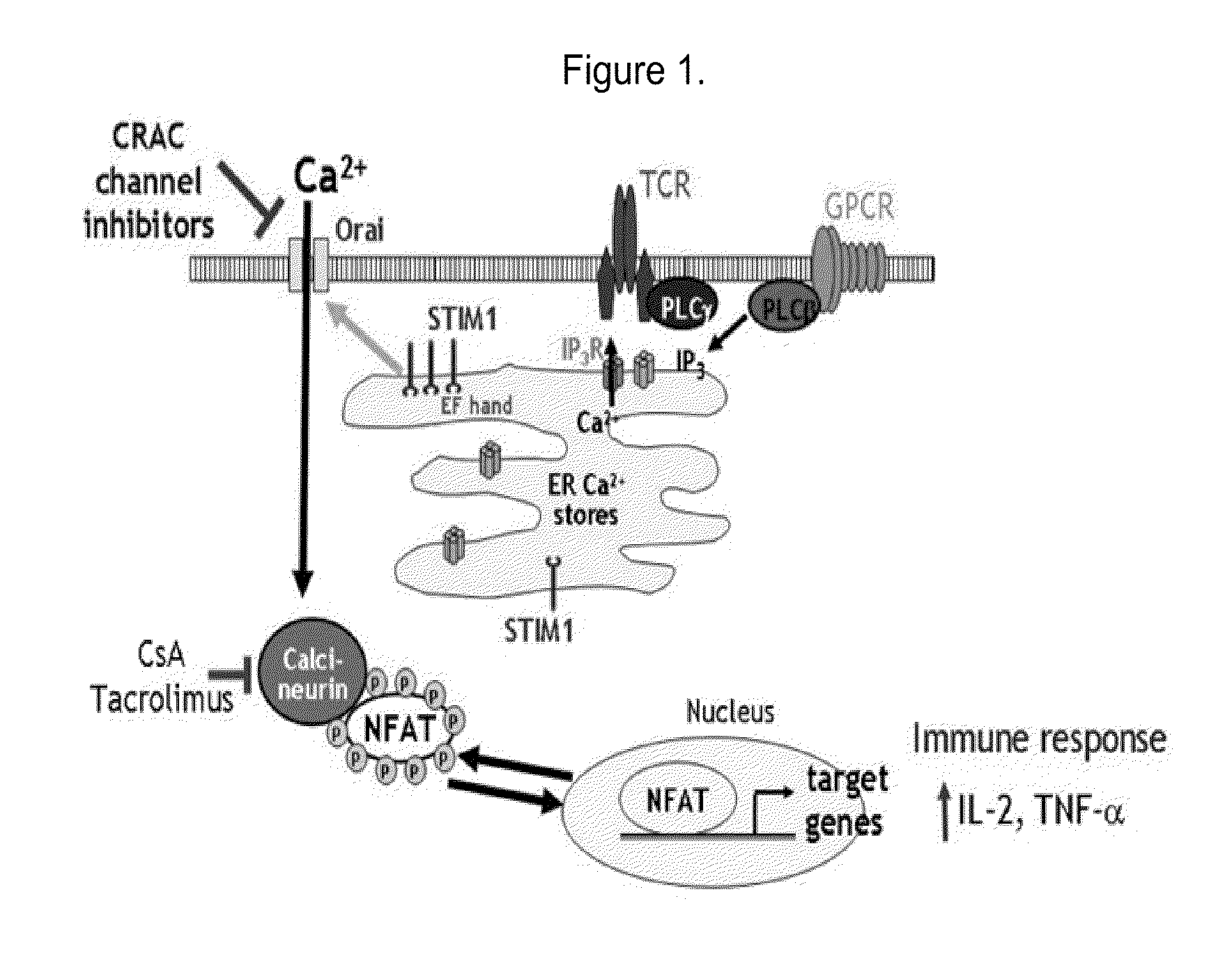Invented by Jeffrey P. Whitten, CalciMedica Inc
SOCR is a process by which calcium ions are released from intracellular stores in response to the depletion of calcium in the endoplasmic reticulum (ER). This process is mediated by a family of proteins called STIM and Orai, which act as calcium sensors and channels, respectively. When the ER calcium stores are depleted, STIM proteins interact with Orai channels, leading to the influx of calcium ions into the cytoplasm. This process is essential for a wide range of cellular functions, including immune cell activation, muscle contraction, and insulin secretion.
However, dysregulation of SOCR can lead to various diseases, including autoimmune disorders, cancer, and cardiovascular disease. Inhibitors of SOCR have emerged as a promising therapeutic strategy for these diseases. These inhibitors can target various components of the SOCR pathway, including STIM and Orai proteins, as well as downstream effectors such as calcineurin and NFAT.
The market for inhibitors of SOCR is expected to grow rapidly in the coming years due to the increasing demand for drugs that can target calcium signaling pathways. According to a report by Grand View Research, the global calcium channel blockers market is expected to reach USD 15.3 billion by 2025, growing at a CAGR of 5.3% from 2018 to 2025. The report attributes this growth to the increasing prevalence of cardiovascular diseases, which are often treated with calcium channel blockers.
In addition to cardiovascular diseases, inhibitors of SOCR are also being developed for the treatment of various other diseases, including cancer and autoimmune disorders. For example, a recent study showed that inhibition of SOCR can enhance the efficacy of chemotherapy in breast cancer cells. Similarly, inhibitors of SOCR have been shown to reduce inflammation in animal models of autoimmune disorders.
Several companies are currently developing inhibitors of SOCR for various indications. For example, CalciMedica is developing CM4620, a small molecule inhibitor of SOCR, for the treatment of acute pancreatitis and acute lung injury. Another company, STORM Therapeutics, is developing small molecule inhibitors of STIM proteins for the treatment of cancer.
In conclusion, the market for inhibitors of SOCR is growing rapidly due to the increasing demand for drugs that can target calcium signaling pathways. These inhibitors have the potential to treat a wide range of diseases, including cardiovascular disease, cancer, and autoimmune disorders. As research in this field continues to advance, we can expect to see more innovative therapies targeting SOCR in the coming years.

The CalciMedica Inc invention works as follows
The present invention describes compounds and pharmaceutical compositions that contain such compounds to modulate the activity store-operated Calcium (SOC) channel. The invention also describes methods for using SOC channels modulators alone or in combination with other substances to treat diseases, disorders, or conditions that could benefit from inhibiting SOC channel activity.

Background for Inhibitors for store-operated calcium release
Calcium is essential for cell survival and function.” Calcium is an important element for the transmission of signals within and between cells. Calcium-dependent processes initiate cellular responses to growth factor, neurotransmitters and hormones, as well as a variety of signal molecules.
Virtually every cell type depends in some way on the generation of Ca2+ signals within the cytoplasm to regulate cell function or trigger specific responses. The cytosolic Ca2+ signal controls a variety of cellular functions, from short-term responses like contraction and secretion through to long-term regulation of growth and proliferation. These signals are usually a combination of Ca2+ release from intracellular stores such as the ER and Ca2+ influx across the plasma membrane. In one instance, activation of the cell begins with a receptor on the surface membrane binding an agonist. This is then coupled to PLC (phospholipase C) via a G protein mechanism. The activation of PLC leads to production of inositol,4,5-triphosphate(IP3) which activates the IP3R receptor causing Ca2+ release from the ER. The decrease in ER Ca2+ signals the activation of plasma membrane store-operated Calcium (SOC) channel.
Store-operated Calcium (SOC), influx, is a process that occurs in the physiology of cells and controls diverse functions, including but not limited, to refilling intracellular Ca2+ storage (Putney, et al.). Cell, 75: 199-201 (1993), activation enzymatic activities (Fagan and al., J. Biol. Chem. 275:26530-26537, 2000), gene transcription (Lewis, Annu. Rev. Immunol. 19:497-521, 2001), cell proliferation (Nunez et al., J. Physiol. 571.1, 56-73, 2006. Opin. Immunol. 15:299-307, 2003). SOC influx is mediated by calcium release-activated (CRAC) calcium channels in some cells that are not excitable, such as blood cells, immune cell, hematopoietic, T lymphocytes, and mast cells.
The calcium influx is referred to by the term store-operated Calcium Entry (SOCE). The stromal interaction molecules (STIM) are essential for SOC channel function. They serve as sensors to detect the depletion in intracellular calcium stores and activate SOC channels.
Compounds of Formula (I), compounds containing such compounds and methods for their use are described herein. Compounds of Formula (I), in another aspect modulate intracellular Calcium by inhibiting store operated calcium channels. Compounds of Formula (I), in a second aspect, modulate intracellular Calcium by inhibiting the activity of activated calcium channel complexes. Compounds of Formula (I), in one aspect, inhibit the activation of stored-operated channels. Compounds of Formula (I), in another aspect, inhibit the activation of calcium release activated calcium channel. Compounds of Formula (I), in another aspect modulate activity, modulate interaction, or modulate level, distribution, or bind, or interact with, at least one SOC channel protein. Compounds of Formula (I), in one aspect, modulate activity, modulate interaction, or modulate level, distribution, or bind or interact with one or more proteins of the CRAC complex. Compounds of Formula (I), in one aspect, are selective inhibitors for CRAC channel activity.
In one aspect of the invention, described is a method for modulating intracellular Calcium by inhibiting store operated calcium channels activity, comprising administration of a compound of Formula I, or a pharmaceutically accepted salt, pharmaceutically accept solvate, and pharmaceutically accept prodrug thereof.
wherein:
The present invention contemplates any combination of the above groups for the different variables.
In one aspect, the present invention describes a method for modulating the activity of store-operated Calcium (SOC), channel complexes, or portions thereof, by contacting them with a compound from Formula (I), a pharmaceutically accepted salt, a pharmaceutically accept solvate or a pharmaceutically accept prodrug of Formula (I). In one embodiment, contacting takes place in vitro. In a different embodiment, the contact occurs in vivo. In one embodiment, Formula (I), binds or interacts with a portion of the stromal interactions molecules (STIM) protein family. In one embodiment, the formula (I) compound modulates activity, modifies interaction, or modifies the level, distributions, or interactions of at least one portion STIM1 or STIM2. Modulating the activity of store operated calcium channels with a formula (I) in one embodiment inhibits store-operated Calcium Entry (SOCE). In a different embodiment, the calcium-release activated (CRAC), channel complex is used as the store operated calcium complex. In one embodiment modulating the calcium release activated (CRAC), activity with a formula (I) compound inhibits the electrophysiological (ICRAC), directly associated with CRAC channels.
In another aspect, the present invention describes a method for modulating calcium-release activated calcium channels (CRAC) in mammals by administering a salt of Formula I, a pharmaceutically accepted solvate or a pharmaceutically approved prodrug of Formula I. In one embodiment, a compound of Formula I modulates activity, interaction, level, distribution, or binding to or interacting with at least one calcium release activated channel complex component selected from the stromal interactions molecules (STIM family) of proteins. In one embodiment, the formula (I) compound modulates activity, interacts, modifies the distributions or levels of STIM1 or STIM2, binds or interacts, and modulates interaction. In one embodiment modulating calcium-release activated calcium (CRAC), channel activity using a Formula (I) compound inhibits store operated calcium entry (SOCE). In one embodiment modulating calcium-release activated calcium (CRAC channel) activity with a formula (I) compound inhibits the electrophysiological (ICRAC), directly associated with activated channels. In one embodiment, Formula (I), a compound, inhibits SOCE at an IC50 of less than 10?M. In another embodiment, Formula (I), at a concentration of less than 10 M, inhibits the electrophysiological current directly associated with CRAC channels.
The In In In one embodiment, the second therapeutic agent is selected from immunosuppressants, glucocorticoids, non-steroidal anti-inflammatory drugs, Cox-2-specific inhibitors, leflunomide, gold thioglucose, gold thiomalate, aurofin, sulfasalazine, hydroxychloroquinine, minocycline, anti-TNF-? Agent In another embodiment, the second therapeutic agent is selected from tacrolimus, cyclosporin, rapamicin, methotrexate, cyclophosphamide, azathioprine, mercaptopurine, mycophenolate, or FTY720, prednisone, cortisone acetate, prednisolone, methylprednisolone, dexamethasone, betamethasone, triamcinolone, beclometasone, fludrocortisone acetate, deoxycorticosterone acetate, aldosterone, aspirin, salicylic acid, gentisic acid, choline magnesium salicylate, choline salicylate, choline magnesium salicylate, choline salicylate, magnesium salicylate, sodium salicylate, diflunisal, carprofen, fenoprofen, fenoprofen calcium, fluorobiprofen, ibuprofen, ketoprofen, nabutone, ketolorac, ketorolac tromethamine, naproxen, oxaprozin, diclofenac, etodolac, indomethacin, sulindac, tolmetin, meclofenamate, meclofenamate sodium, mefenamic acid, piroxicam, meloxicam, celecoxib, rofecoxib, valdecoxib, parecoxib, etoricoxib, lumiracoxib, CS-502, JTE-522, L-745,337 and NS398, leflunomide, gold thioglucose, gold thiomalate, aurofin, sulfasalazine, hydroxychloroquinine, minocycline, infliximab, etanercept, adalimumab, abatacept, anakinra, interferon-?, interferon-?, interleukin-2, allergy vaccines, antihistamines, antileukotrienes, beta-agonists, theophylline, and anticholinergics.
The present invention also describes a method for inhibiting the store-operated Calcium Entry (SOCE) activation nuclear factor of activated cells (NFAT) of a mammal by administering a formula (I) compound, or a pharmaceutically accepted salt, pharmaceutically accept solvate, and pharmaceutically unacceptable prodrug thereof. In one embodiment, the formula (I) compound modulates an interaction, or modulates levels or distributions, or binds or interacts with mammalian proteins STIM1 or STIM2.
Also, provided herein is a technique for decreasing cytokine production by inhibiting store-operated Calcium entry activation of NFAT, comprising administering a drug of Formula I, or a pharmaceutically accepted salt, pharmaceutically accept solvate, and pharmaceutically accept prodrug thereof. In one embodiment, the formula (I) modulates a level or distribution of a mammalian protein STIM1 or STIM2. It may also bind to or interact with the protein. In one embodiment, the cytokine is selected from IL-2, IL-3, IL-4, IL-5, IL-6, IL-7, IL-8, IL-9, IL-10, IL-11, IL-12, IL-13, IL-15, IL-16, IL-17, IL-18, IL-1?, IL-1?, IL-1 RA, granulocyte colony stimulating factor (G-CSF), granulocyte-macrophage colony stimulating factor (GM-CSF), oncostatin M, erythropoietin, leukemia inhibitory factor (LIF), interferons, gamma-interferon (?-IFN), B7.1 (CD80), B7.2 (B70, CD86), TNF-?, TNF-?, LT-?, CD40 ligand, Fas ligand, CD27 ligand, CD30 ligand, 4-1BBL, Trail, and migration inhibitory factor (MIF).
In one aspect of the invention, a compound of Formula I, or a pharmaceutically accepted salt, pharmaceutically accept solvate, and pharmaceutically accept prodrug thereof is used to formulate a drug for modulation store operated Calcium (SOC), channel activity, in a patient or for treatment of disease, disorder, or condition that could benefit from modulation store operated Calcium (SOC), channel activity. In one embodiment, Formula (I), or a salt thereof, inhibits store-operated calcium entry (SOCE). “In another embodiment, store operated calcium channel activities is calcium release activated channel activity.
The article of manufacture also includes packaging material, a composition or compound of Formula I, or a pharmaceutically accepted salt, pharmaceutically accept prodrug or pharmaceutically unacceptable solvate of it, that is effective to inhibit calcium release activated calcium (CRAC), or that is useful for treating, preventing or alleviating one or more of the symptoms of disease, disorder, or condition which would be improved by the inhibition calcium release activated calcium (CRAC). In one embodiment, the formula (I) compound inhibits store-operated calcium entry (SOCE).
In one aspect of the invention, a pharmaceutical composition is described that comprises a pharmaceutically accepted diluent or excipient, a pharmaceutically accept prodrug or a pharmaceutically accept solvate, as well as a compound from Formula (I).
In one embodiment, a pharmaceutical composition is provided, which contains an effective amount of the compound herein and a pharmaceutically accepted excipient. Compositions containing a second active pharmaceutical ingredient are also provided in a different embodiment.
In certain embodiments of the invention, there is provided a pharmaceutical composition that contains: i), a physiologically acceptible carrier, diluent and/or excipient, and ii), one or more compounds as described in this invention.
In any of these aspects, there are additional embodiments which include single administrations (of the effective amount) of the compound Formula (I), such as further embodiments where: (i), the compound Formula (I), is administered only once; (ii), the compound Formula (I), is administered multiple times to the mammal over the course of one day; or (iii), continuously.
In any of the above aspects, there are additional embodiments which include multiple administrations (e.g.) of the effective dose of the formula (I), such as (i) a compound of Formula I is administered only once; (ii), the interval between multiple administrations (e.g.) every six hours; and (iii), the compound Formula I is administered to the animal every eight hours. In other embodiments, the process includes a drug-holiday, in which the administration of Formula I is temporarily suspended, or the dose is temporarily reduced. At the end of this drug holiday the dosing is resumed. The length of the drug holidays can vary from 2 days up to 1 year in some embodiments.
In one embodiment, the compounds of Formula (I), described herein, are administered to an individual. Compounds of Formula (I), described herein, are administered orally in some embodiments.
Click here to view the patent on Google Patents.

Leave a Reply